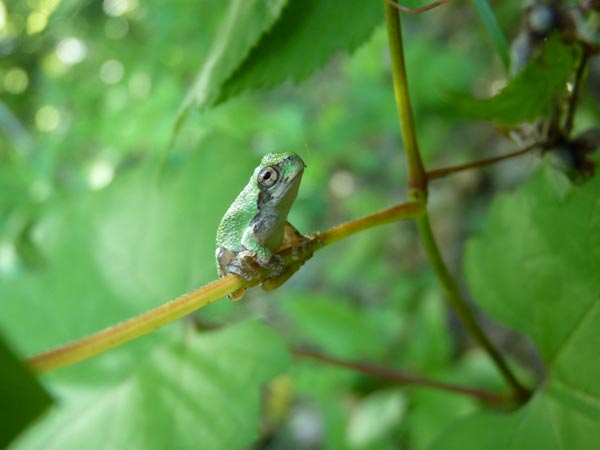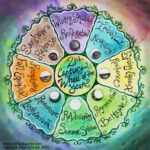As we quickly approach the most consumptive season of the year, I wanted to post about ways that you can reduce your overall impact on the planet. I think its critically important that we, as druids and other earth-centered spiritual people, set an example for others to follow. So when people ask, “what do you believe” you can instead respond with “this is what I believe and here’s how I enact it in my daily life.” Without changing our own behaviors and practices, we can’t be that example for others to follow. So with that said, this blog post will detail ten ways that you can start reducing your impact.
1) Reduce your overall buying, and if you have to buy, buy used. I posted about this some time ago–and its critically important that we carefully monitor what we buy and how we buy it. Each time we buy a product, we are sending a message to that company that says, “Hey make more of these, cause people want them.” So reduce demand not buying, or if you have to buy, buying used. This creates less strain and demand on the whole system.

2) When you buy, pay attention to who you buy it from and what they stand for. Each time we buy a product, we also inadvertently fund that company’s political initiatives, which after Citizens United, can be seriously ethically questionable. Think of your dollars like a vote–each time you spend, you are voting in favor or against certain viewpoints. In the last election, California’s GM-Labeling proposition was defeated by millions in dollars in spending from food companies. We also have oil companies actively lobbying and writing their own policies, restaurants openly attacking gay rights, and phone companies supporting extremist tea-party candidates who are anti-environmental and anti-science. If we stop buying from these companies, this sends a clear message and erodes their financial ability to support such environmentally and socially destructive policies. A few years ago, after learning about AT&T’s funding of tea party candidates, we switched to Credo Mobile, a progressive company who openly and actively funds environmental and humanitarian groups. We also buy everything that we need locally, so that we keep money within our local area, rather than going to businesses that might not even be paying taxes in the USA.
3) Drive less. When you have to drive, combine trips. Use public transportation if available. Unlike phone companies where switching to a different one is relatively straightforward, its quite hard (although not impossible) to avoid supporting big oil’s anti-environmental agenda. To combat this, we carpool, combine trips, and drive a very fuel-efficient hybrid car. But even these activities hardly seem like enough, although they are something. We have virtually no public transportation in our area, unfortunately (Detroit, being “motor city” and all, has none), so we decided to invest in a very fuel efficient car to offset this lack.
4) Eat locally and seasonally. I’ve also blogged about this before, and suggested six principles for local eating. The further your food has to travel, the more fossil fuels are burnt to create it. Furthermore, when you purchase food from big agriculture, rather than from small farms, you are buying food that has been produced using fossil fuel fertilizers, fossil fuel machines, genetically modified crops, and various pesticides. By shifting to a local, seasonal diet that is purchased locally from small, independent, organic farmers, you are reducing the amount of fossil fuel to get your food from farm to plate. You are also supporting sustainable agriculture and a new generation of farmers. Its a really good thing :).
5) Grow your own food. You should also seriously consider starting your own garden. I’ve provided numerous techniques on this blog for starting gardens, extending the growing season, and preserving food. If you use organic methods, saving seeds from year to year and building your soil with what is on your property, you can have lovely and delicious vegetables with virtually no carbon footprint. If you are living in an apartment, you should check out R&DIY, which is a great site for window gardening in small spaces.
6) Reduce your meat (especially beef) consumption. Beef (and other meat consumption) is very environmentally destructive. Even if you don’t shift to a completely vegetarian diet, reducing your beef consumption (especially imported beef, from places like Brazil who are losing rainforest at an alarming rate to support the American Beef industry). While this takes some shifting of your eating habits, you will find that there are many wonderful alternatives out there! The other issue with meat is that it takes double or more the amount of corn/grains to produce a pound of beef–and those grains could be used for feeding people or using less available farmland.

7) Avoid other foods that are environmentally destructive. Foods you might not suspect also have a substantial environmental toll. Most dairy (cheese, milk, butter) is tied up with the cattle industry, which also is responsible for alarming rates of CO2 as well as unethical treatment of animals. Fish farming has been demonstrated to cause substantial problems with coastal areas. Palm oil is another food that is very environmentally destructive.
8) Reduce your energy consumption. Have an energy audit done in your home. Reduce your thermometer by 3 degrees in the winter, and raise it by 3 degrees in the summer (or forgo AC entirely). Wear layers of clothing, and focus on heating areas of your house rather than the whole house. Turn off the lights when they are not in use. Make sure that machines are unplugged when not in use. If you have to buy new appliances, buy Energy Star rated appliances. There are lots of ways to reduce your energy consumption!
9) Convert your lawn to edible, wildlife-friendly gardens. The typical green American lawn is a huge site of environmental pollution and waste. Mowing the lawn requires heavy equipment and fossil fuels, more fossil fuels are dumped on it to keep it green and free of weeds, and the space is not habitat or food production for most wildlife or human life. Not to mention the water stress that’s involved in watering the lawn to keep it looking nice. When we purchased our house, we had about 2 acres of lawn (of three acres, the rest was a pond and a bit of forest and the house itself). I quickly took to only mowing paths through 2/3 of it and letting it grow as it saw fit. I still did mow select areas in the front. But over the last two years, I’ve been converting it to productive space one area at a time: a butterfly garden and stone path now takes up a sunny spot facing the south of the house; a huge vegetable garden now takes up much of the center area; and numerous fruit and nut trees have been planted and mulched. The next projects include a sunflower and sunchoke bed, a golden raspberry planting area, and an edible and walkable labyrinth.

10) Reduce your waste and start composting. Recycling is often the first thing that people think of concerning environmentally-friendly behaviors. And yes, its a great start! The problem with recycling, however, is that most of the waste in your products is not the products themselves, but the waste from producing the products (The Story of Stuff explains this quite nicely). This is why #1 and #2 are so important on my list (and are #1 and #2, rather than #10). Recycling and composting are excellent activities, but should be supplemented with other earth-friendly behaviors.
While this list is not exhaustive, I think this list can help get you in the mindset of reducing your environmental impact. And getting in the mindset is key–once you have made that shift away from the status quo, its amazing how many things you can find to do each day that can help build a better world.



All good ideas and I’m glad you’re promoting them. I hope your blog goes global!!
however, some of us who grew up on the edge of hippiedom, have lived like this since the 60s. Yes, I have occasionally splurged, but about the mowing. I have found that the ticks and fleas back off when the grass is mowed (I hate grass, always have. But it was 8 ft tall when we moved in…) So, the cost of flea and tick poison on the animals and myself is offset by the mowing. We’ll continue that.
All burnables go in my woodstove and then into the compost bins.. we have 3 and ‘make a lot of dirt’ 😀 I’d garden if I didn’t have so much arthritis. I’ve tried to get our property into a community garden, but no one is interested (and yes, I’d produce the water for my share as well as the property)…
I even tried to get someone interested in putting in hives. He wanted a minimum of 5 acres (we have one).
I’ve driven cars with great gas mileage for 20 yrs, without using a hybrid (42 mpg.. hybrids use electricity produced by coal-driven power plants. Not cool.)
Unfortunately, I see people around me who throw out ‘stuff’ every 6 months. And then buy new. (What’s up with that????) I have antiques. It’s a choice, but I love them. I have also been known to refinish the furniture or reupholster instead of buy new.
I’ll be reading more of your blog. It’s interesting. And I like to know the younger generation is trying their best 😀
Thanks for posting, Meran! Most people aren’t living this way now, which is why I posted the blog 🙂
Don’t I know it 🙁
I’m in ‘rural’ Oregon, but even in ‘citified’ Oregon, they THINK they live green…. while they look for the new landfill since all the others are full..
I’d love to live near you. We could share resources!
oh, and ‘rural’ Oregon is very NOT into the whole green thing, not for real and not for pretend.
There are a few, but they aren’t near me. It’s even illegal to have or sell raw milk (I lived on it in Maine for 5 yrs. Two places I lived were a mile or two from a dairy. I got it ~warm….)
Raw milk is ambiguous here. Basically, the way people do it is by herdshares. so you purchase a “share” of a cow and then you can buy raw milk from the farmer.